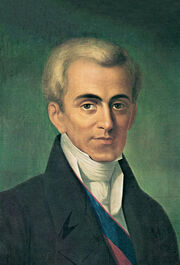| Republic of Byzantium | ||||||
| ||||||
| ||||||
| Capital | Constantinople | |||||
| Government | Presidential republic | |||||
| President | Donus Tzimiskes | |||||
| Legislature | Byzantine Senate | |||||
| History | ||||||
| - | Empire abolished | 13 February 1801 | ||||
| - | Kingdom established | 31 July 1805 | ||||
The Republic of Byzantium was a short-lived state in the early 19th century that existed from the fall of the Byzantine Empire in 1801 until the creation of the modern Kingdom of Byzantium in 1805. It was the first state to be officially called Byzantium.
By the 1760s, the Byzantine Empire had entered an era of political conflict, with many supporting the abolition of the monarchy. Even though the country was a parliamentary monarchy, the Emperor was considered to hold still too much power. This culminated in 1797 with a French Revolution-inspired civil war, in which several political opponents fought. The war ended in 1801 with the foundation of the Republic of Byzantium. The new government was originally intended to be provisional and be replaced within a few months, but ended up lasting more than four years.

Donus Tzimiskes (1865-1807). The only Byzantine President.
The republic was initially popular among the Byzantine lower classes and compared to Plato's Republic. However, its increasingly unstable economy caused by the recent war and the ongoing Varangian Rebellion generated dissatisfaction across the nation, and the political crisis persisted. By 1805, Byzantium was facing a severe unemployment crisis. On 13 June, a failed assassination attempt on President Donus Tzimiskes prompted another national revolt. After a plebiscite, the monarchy was restored under a democratic constitution. However, the new monarchy was not called an "empire" anymore, but a "kingdom" instead, and the monarch lost many of his powers, including his ability to dissolve parliament and appoint ministers, although he still had considerable command over the armed forces.
Presidential selection
After the war the selection of the President was needed with 3 major candidates; Christianos Mestabolus, who lead the Cretan forces and the Navy, Donus Tzimiskes, a commander who had the support of the Russian oligarchary, Herkules Gregorius, who oversaw the diplomatic relations of the revolt. Mestabolus passed away during the conference from old age at 81 and a compromise allowed Donus to take the Presidency whilst Herkules and his allies got many cabinet positions.
| ||||||||||||||||||





